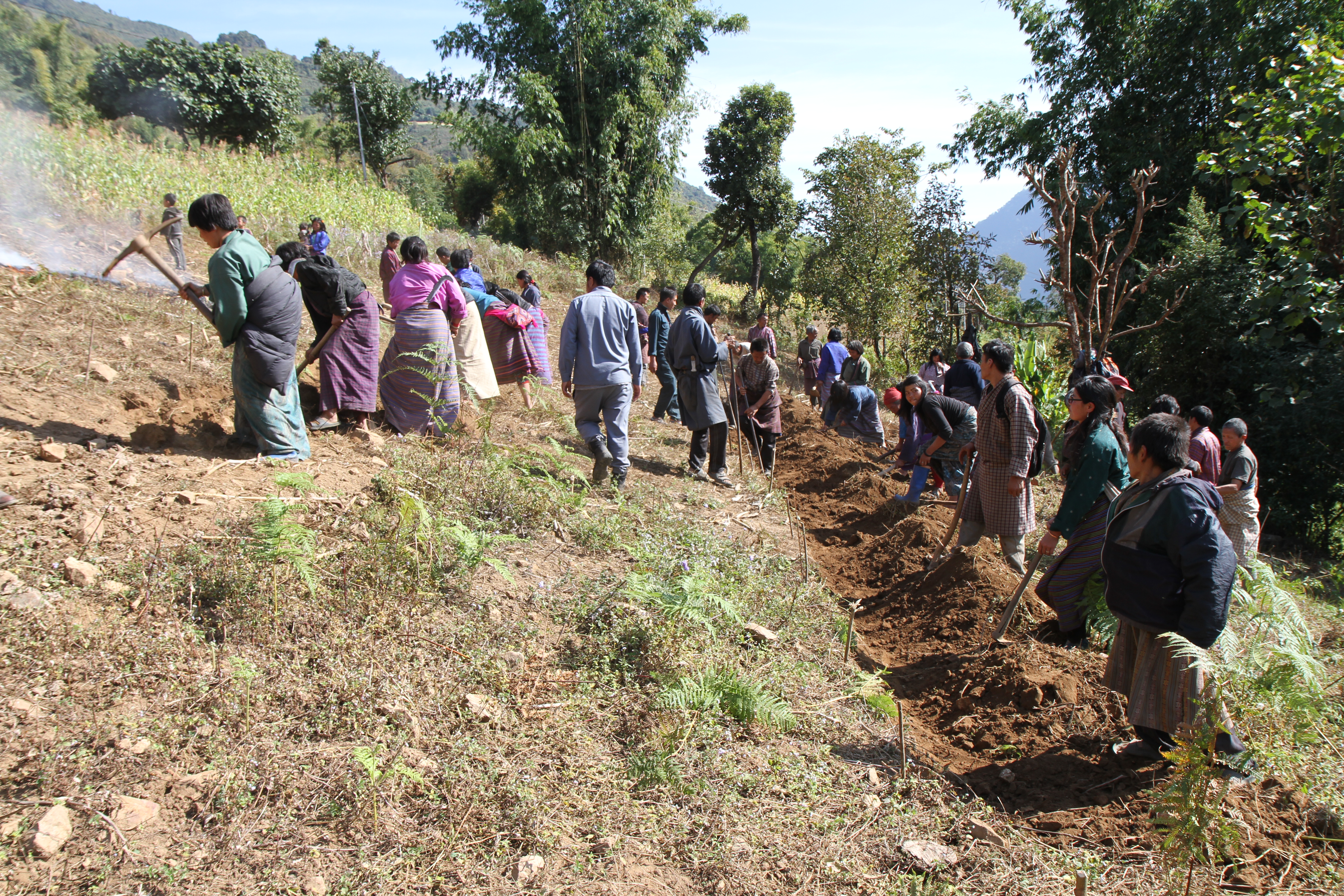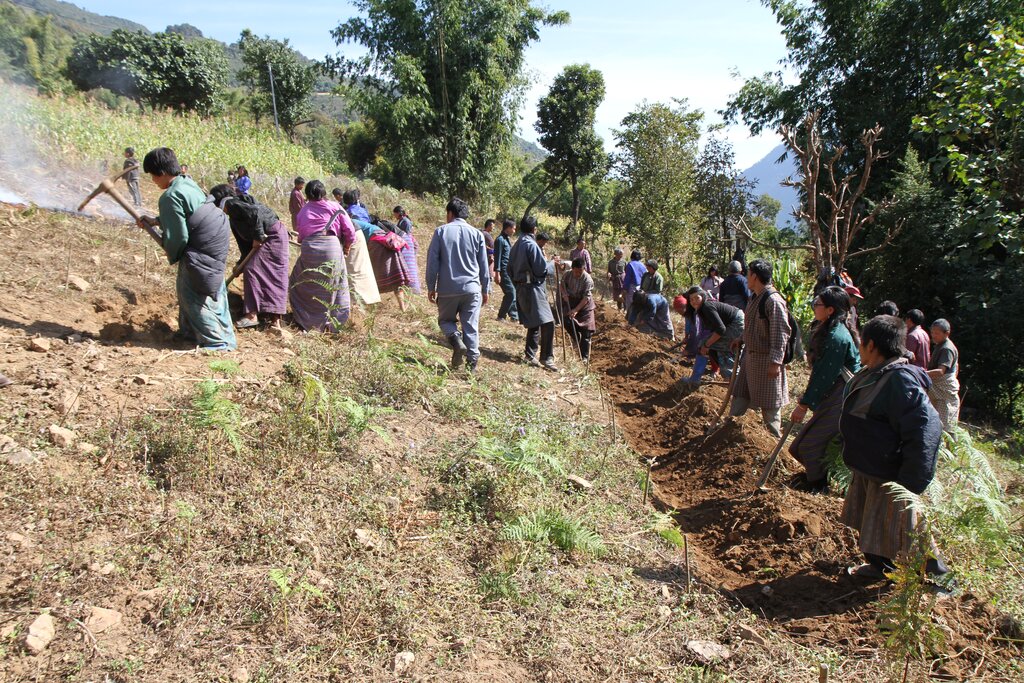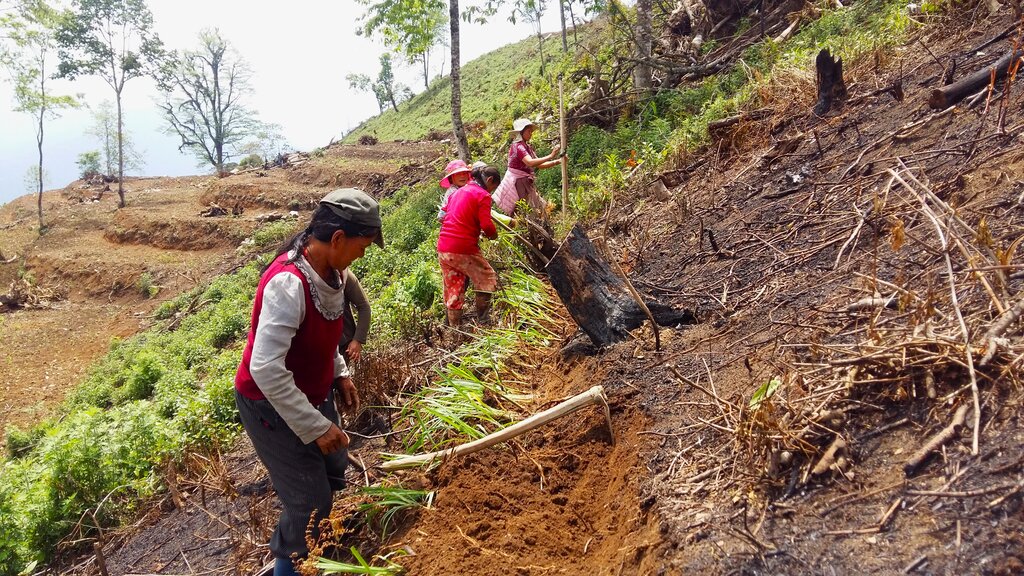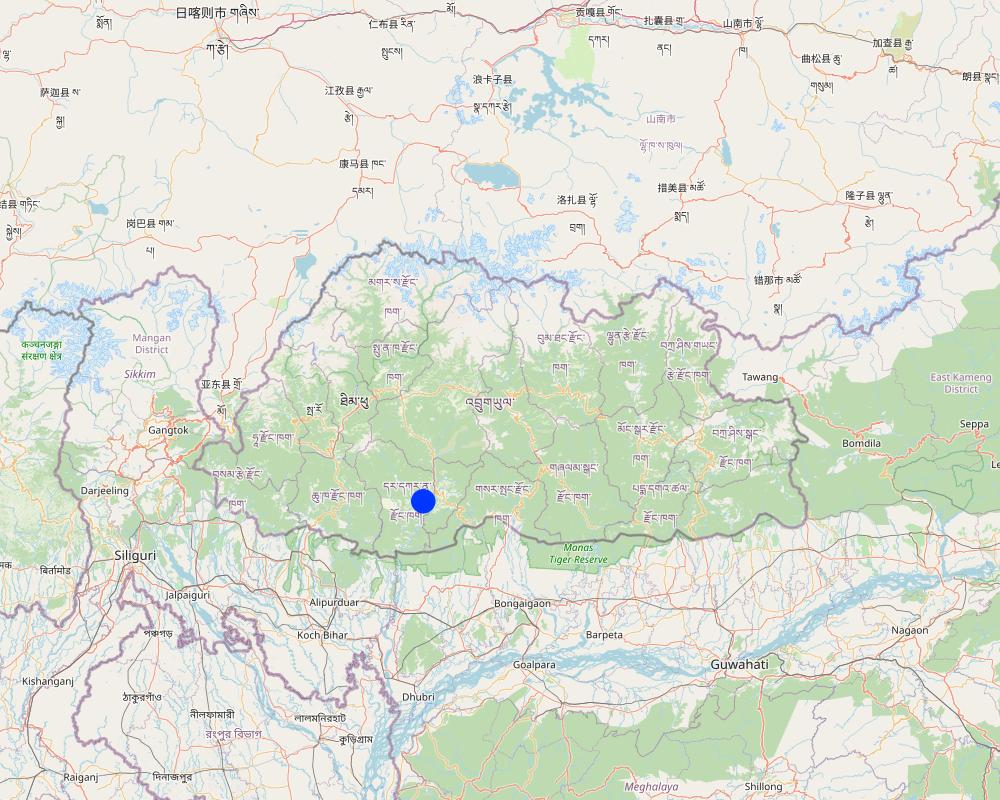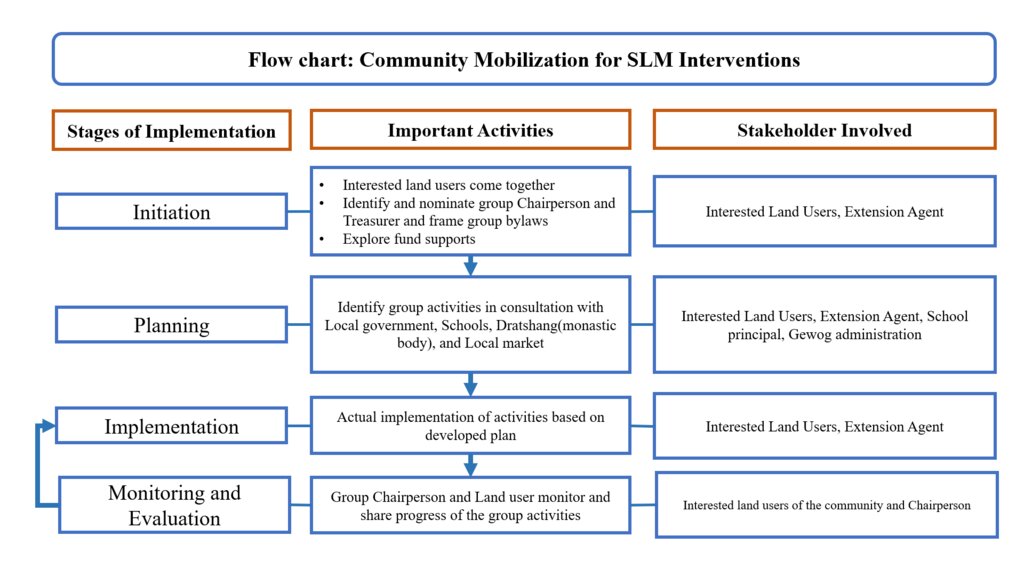Community Mobilization for SLM Interventions [Bhutan]
- Creation:
- Update:
- Compiler: Nima Dolma Tamang
- Editor: –
- Reviewers: William Critchley, Rima Mekdaschi Studer, Joana Eichenberger
Yuenten Sazhi Zinchong Laglen Thab Niyi Dhoen lu Midhey Dreltog (ཡུན་བརྟན་ས་གཞི་འཛིན་སྐྱོང་ལག་ལེན་འཐབ་ནིའི་དོན་ལུ་མི་སྡེ་འབྲེལ་གཏོགས།)
approaches_6835 - Bhutan
View sections
Expand all Collapse all1. General information
1.2 Contact details of resource persons and institutions involved in the assessment and documentation of the Approach
Key resource person(s)
land user:
Tashi Tshering
17618478
Pangserpo Chiwog, Drujeygang Gewog, Dagana Dzongkhag
Bhutan
land user:
Pem (B) Tshering
17778420
Pangserpo Chiwog, Drujeygang Gewog, Dagana Dzongkhag
Bhutan
land user:
Mo Lungten
17826655
Pangserpo Chiwog, Drujeygang Gewog, Dagana Dzongkhag
Bhutan
land user:
Mo Karchang
17643440
Pangserpo Chiwog, Drujeygang Gewog, Dagana Dzongkhag
Bhutan
land user:
Pem (A) Tshering
77894830
Pangserpo Chiwog, Drujeygang Gewog, Dagana Dzongkhag
Bhutan
Name of project which facilitated the documentation/ evaluation of the Approach (if relevant)
Strengthening national-level institutional and professional capacities of country Parties towards enhanced UNCCD monitoring and reporting – GEF 7 EA Umbrella II (GEF 7 UNCCD Enabling Activities_Umbrella II)Name of the institution(s) which facilitated the documentation/ evaluation of the Approach (if relevant)
National Soil Services Centre, Department of Agriculture, Ministry of Agriculture & Livestock (NSSC) - Bhutan1.3 Conditions regarding the use of data documented through WOCAT
When were the data compiled (in the field)?
07/07/2023
The compiler and key resource person(s) accept the conditions regarding the use of data documented through WOCAT:
Yes
1.4 Reference(s) to Questionnaire(s) on SLM Technologies
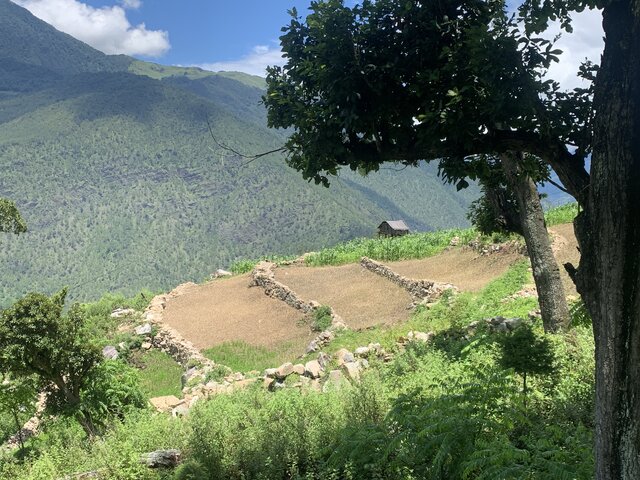
Contour Stone Bunds [Bhutan]
Contour stone bunding on sloping agricultural lands reduces soil erosion and conserves soil moisture in order to retain soil productivity. It is promoted /recommended on slopes where there is adequate surface stone.
- Compiler: Nima Dolma Tamang
2. Description of the SLM Approach
2.1 Short description of the Approach
Community mobilization in implementing sustainable land management technologies is indispensable in engaging the community to identify their priorities, resources, needs and solutions. It ultimately promotes bottom-up participation and fosters accountability.
2.2 Detailed description of the Approach
Detailed description of the Approach:
Community mobilization in implementing sustainable land management technologies involves active engagement of local communities in the planning, decision-making, implementation, and monitoring of land management. This approach recognizes the vital role of local communities in managing and conserving natural resources. By actively involving community members, SLM initiatives can be more effective and sustainable in the long-run.
With the objective of promoting a sense of unity and shared responsibility, SLM implementation in Pangserpo Chiwog of Drujeygang Gewog under Dagana Dzongkhag, has been executed through mobilization of a community group called ‘Thuenpa Puenzhi Sonam Detshen’. This group, consisting of 13 members, was initially instituted as a vegetable progressive group in 2018.
The need for SLM came to light when one of the members adopted stone bunds, inspiring the rest of the members. Subsequently, the community group members collectively initiated an SLM programme to address land degradation issues and enhance agriculture productivity. The proven SLM technologies implemented includes stone bunds, terracing, and hedgerows.
The community mobilization approach has built capacity within the community for effective land use and conservation, fostering ownership and securing the longevity of the SLM programme. The bylaws - for instance mandatory active participation of every member in community work - have been successful in upholding the integrity of the initiative, thereby ensuring effective implementation of SLM related activities.
This group mainly consists of women headed households who support each other through a self-help approach. When labour shortage is the major challenge, the self-mobilized group plays a vital role in scaling up SLM interventions and improving their own livelihoods. In most cases of SLM grouping, the groups remain intact until project support is withdrawn, but for the Thuenpa Puenzhi Sonam Detshen, the group is still functional.
2.3 Photos of the Approach
2.5 Country/ region/ locations where the Approach has been applied
Country:
Bhutan
Region/ State/ Province:
Dagana Dzongkhag
Further specification of location:
Pangserpo Chiwog, Drujeygang Gewog
Map
×2.6 Dates of initiation and termination of the Approach
Indicate year of initiation:
2019
Comments:
The group evolved from the vegetable group to the SLM group as the Chairman observed the effectiveness of stone bunds in land management. He initiated the construction of a stone bund which inspired other land users to adopt SLM technologies such as stone bunds, terracing and hedgerows. The land users are aware of the importance of land management to improve agricultural productivity which ensures sustainability of the approach. Furthermore, it continuously explores the market within and outside the country which motivates the group members to conserve land using the SLM measures.
2.7 Type of Approach
- recent local initiative/ innovative
2.8 Main aims/ objectives of the Approach
The central goal of this approach is to foster community interaction and collaboration towards better outreach and implementation of SLM practices
2.9 Conditions enabling or hindering implementation of the Technology/ Technologies applied under the Approach
social/ cultural/ religious norms and values
- enabling
The socio-cultural norms enable the implementation of SLM activities in the community, due to its effectiveness in mitigating land degradation issues, with no negative side impact.
availability/ access to financial resources and services
- enabling
Initially the the government funded Nu. 200,000/- to execute the SLM technologies (stone bunds), later the group became financially stable by collecting fees (Nu.500 per member) from the group members and selling their agricultural products.
institutional setting
- enabling
The community have better access to gewog Renewable Natural Resources, Agriculture Research and Development Centre, and National Soil Services Centre for any kind of technical supports related to SLM
collaboration/ coordination of actors
- enabling
The land users collaborated with the Royal Government of Bhutan and Green Climate Fund project members for the execution of the community SLM interventions.
legal framework (land tenure, land and water use rights)
- enabling
The land ownerships for instance are either family or individual, posing no hindrances to adopt any kind of SLM technologies.
policies
- enabling
There is no policies that hinders the SLM intervention in the community
land governance (decision-making, implementation and enforcement)
- enabling
The community holds meetings every month to discuss their issues and plans. By-laws were formulated during the initiation of the approach to enable efficient decision-making and implementation of the activities. Additionally, regardless of gender, land users actively participate in the activities that were done as part of the approach.
knowledge about SLM, access to technical support
- enabling
The members were well sensitized and trained on SLM and its best technologies by the National Soil Services Centre
markets (to purchase inputs, sell products) and prices
- enabling
The market for the community is assured through school feeding program linkage (Drujeygang Central School and Pangna Primary Schools).
workload, availability of manpower
- enabling
The SLM practices such as the construction of stone bunds are laborious. However, the involvement of the community and their labour contribution aids in achieving the implementation of the SLM practices.
3. Participation and roles of stakeholders involved
3.1 Stakeholders involved in the Approach and their roles
- local land users/ local communities
Chairman and community members (land users)
The chairman was involved in initial group formulation by gathering like-minded members, and exploring for input subsidies. Land users are involved in forming a group and cooperating to address the issues, vegetable cultivation, and marketing.
- SLM specialists/ agricultural advisers
Gewog/Block and Dzongkhag agriculture offices
In accepting and reviewing the group formation proposal, developing by-laws , sourcing funds, exploring markets, and monitoring.
- teachers/ school children/ students
School Administrations
For community group and school feeding program linkages
- local government
Gewog/Block Administration
In accepting and reviewing the group formation proposal, developing by-laws , sourcing funds, exploring markets, taking the concerns of land degradation to the higher authorities
- national government (planners, decision-makers)
Dzongkhag Adminstration
Final approval of the group formation and fund sourcing
- international organization
Green Climate Fund (GCF) project
Provision of funds
3.2 Involvement of local land users/ local communities in the different phases of the Approach
| Involvement of local land users/ local communities | Specify who was involved and describe activities | |
|---|---|---|
| initiation/ motivation | self-mobilization | One of the community members who is currently the chairperson adopted a SLM technology, and inspired other members. Subsequently, they further explored to implement SLM technologies in larger scales in the community. |
| planning | interactive | Both the government and the land users were involved during the planning process. The government provided technical inputs whereas the land users contributed traditional knowledge. |
| implementation | interactive | Both the government and the land users were involved during the implementation of the technologies. Where the government provided technical and financial support along with machineries. The land users contributed labour and farm tools. |
| monitoring/ evaluation | interactive | The community meets every month to engage in self-monitoring and evaluation of the technologies. It is followed by addressing the issues and concerns raised. The Gewog, Dzongkhag, and NSSC also conducts periodic monitoring and evaluation. |
3.3 Flow chart (if available)
Description:
Flow chart of how any SLM activities are carried out based on the approach.
Author:
Ongpo Lepcha
3.4 Decision-making on the selection of SLM Technology/ Technologies
Specify who decided on the selection of the Technology/ Technologies to be implemented:
- all relevant actors, as part of a participatory approach
Explain:
The community members were sensitized on SLM by NSSC, followed by bottom-up participatory SLM action planning and field based hands on training.
Specify on what basis decisions were made:
- personal experience and opinions (undocumented)
4. Technical support, capacity building, and knowledge management
4.1 Capacity building/ training
Was training provided to land users/ other stakeholders?
Yes
Specify who was trained:
- land users
- field staff/ advisers
If relevant, specify gender, age, status, ethnicity, etc.
All the members (both male and female) were trained.
Form of training:
- demonstration areas
- public meetings
Subjects covered:
What actually SLM is, why SLM is important and required, and the best proven SLM technologies that are being implemented in Bhutan.
4.2 Advisory service
Do land users have access to an advisory service?
Yes
Specify whether advisory service is provided:
- on land users' fields
Describe/ comments:
The advisory services on the technology and management were provided to farmers on land users' fields by Agriculture Extension Officers.
4.3 Institution strengthening (organizational development)
Have institutions been established or strengthened through the Approach?
- yes, moderately
Specify the level(s) at which institutions have been strengthened or established:
- local
Describe institution, roles and responsibilities, members, etc.
The institution is known by the name "Thuenpa Puenzhi Sanam Detshen" in the surrounding community. There are 13 members including the chairperson of the group. The chairperson's responsibility is to coordinate and address all community-related activities and concerns. He also oversees the institution's financial planning. The member's job is to cooperate with the chairperson and encourage one another in difficult times.
Specify type of support:
- financial
- capacity building/ training
- equipment
- labour-sharing (Local name: Lagtshab)
Give further details:
The institution provides financial aid. Additionally, they engage in labour-sharing (lagtshab) where the land users rotate working on each other's fields to complete the work faster.
4.4 Monitoring and evaluation
Is monitoring and evaluation part of the Approach?
Yes
Comments:
The monitoring and evaluation are part of the approach. The land users get together once a month to review the activities conducted and plan future activities preventing recurring issues to strengthen the effectiveness of the approach.
If yes, is this documentation intended to be used for monitoring and evaluation?
No
4.5 Research
Was research part of the Approach?
No
5. Financing and external material support
5.1 Annual budget for the SLM component of the Approach
If precise annual budget is not known, indicate range:
- < 2,000
Comments (e.g. main sources of funding/ major donors):
The government funded one time during the initial implementation of the technology. However, there is no annual budget allocated for the group now.
5.2 Financial/ material support provided to land users
Did land users receive financial/ material support for implementing the Technology/ Technologies?
Yes
If yes, specify type(s) of support, conditions, and provider(s):
They were provided with Nu. 200,000/- to implement the technology through GCF project.
5.3 Subsidies for specific inputs (including labour)
- equipment
| Specify which inputs were subsidised | To which extent | Specify subsidies |
|---|---|---|
| machinery | partly financed | Power tiller was partly financed by the government. (Farmers and the government split the cost by 50%) |
- agricultural
| Specify which inputs were subsidised | To which extent | Specify subsidies |
|---|---|---|
| seeds | fully financed | Initially all the seeds were provided by the government later it was stopped as the land users became financially stable to afford the seeds. |
- infrastructure
| Specify which inputs were subsidised | To which extent | Specify subsidies |
|---|---|---|
| Greenhouse | partly financed | The government paid 80% of the greenhouse's cost, and farmers paid 20%. |
If labour by land users was a substantial input, was it:
- voluntary
5.4 Credit
Was credit provided under the Approach for SLM activities?
Yes
Specify conditions (interest rate, payback, etc.):
The credit was provided to the community members from the group fund of the group without any interest.
Specify credit providers:
Chairperson and assistant
Specify credit receivers:
Group members including the chairperson.
5.5 Other incentives or instruments
Were other incentives or instruments used to promote implementation of SLM Technologies?
No
6. Impact analysis and concluding statements
6.1 Impacts of the Approach
Did the Approach empower local land users, improve stakeholder participation?
- No
- Yes, little
- Yes, moderately
- Yes, greatly
The land users are now empowered and are able to implement SLM technologies on their own, because of capacity built through SLM sensitization and hand-on-training.
Did the Approach enable evidence-based decision-making?
- No
- Yes, little
- Yes, moderately
- Yes, greatly
The approach enabled land users to make evidence-based decisions. For example, the land users grew certain crops to be sold to the local market. However, the members of other communities started growing the same types of crops. Therefore, to reduce market competition the land users opted for different crops that are not grown by other groups. Also, linking with school feeding program was also a best evident decision.
Did the Approach help land users to implement and maintain SLM Technologies?
- No
- Yes, little
- Yes, moderately
- Yes, greatly
The group members collectively could source funds for SLM. The technology implementation through labour sharing was possible only due to the group members cohesiveness.
Did the Approach improve coordination and cost-effective implementation of SLM?
- No
- Yes, little
- Yes, moderately
- Yes, greatly
The labour sharing strategy proved best in effective cost management (cost sharing).
Did the Approach mobilize/ improve access to financial resources for SLM implementation?
- No
- Yes, little
- Yes, moderately
- Yes, greatly
The group sourced Nu. 200,000/- for the implementation of SLM technologies. Currently, the group makes Nu. 30,00,000/- a year, which they divide among themselves and save a certain amount to be used to maintain the technologies and as an emergency fund.
Did the Approach improve knowledge and capacities of land users to implement SLM?
- No
- Yes, little
- Yes, moderately
- Yes, greatly
Capacity built through SLM sensitization, hand-on-training, and implementation.
Did the Approach improve knowledge and capacities of other stakeholders?
- No
- Yes, little
- Yes, moderately
- Yes, greatly
The capacities of local government officials were developed, while making their presence during the program.
Did the Approach build/ strengthen institutions, collaboration between stakeholders?
- No
- Yes, little
- Yes, moderately
- Yes, greatly
Based on the community's interest and motivation to improve agricultural productivity, other stakeholders are convinced to support and collaborate with them.
Did the Approach mitigate conflicts?
- No
- Yes, little
- Yes, moderately
- Yes, greatly
The labour sharing mechanism through this approach has mitigated social conflicts especially due to labour shortage.
Did the Approach empower socially and economically disadvantaged groups?
- No
- Yes, little
- Yes, moderately
- Yes, greatly
The group members mainly consists of women headed households.
Did the Approach improve gender equality and empower women and girls?
- No
- Yes, little
- Yes, moderately
- Yes, greatly
Both male and female have equal rights to be part of the group. Initially, the group started with an equal number of male and female.
Did the Approach encourage young people/ the next generation of land users to engage in SLM?
- No
- Yes, little
- Yes, moderately
- Yes, greatly
Majority of the children are in schools/colleges. But, they somehow get to engage in SLM program during their vacations representing their parents and relatives. Few youth living in the community are also engaged. Hence, the next generation land users are encouraged.
Did the Approach improve issues of land tenure/ user rights that hindered implementation of SLM Technologies?
- No
- Yes, little
- Yes, moderately
- Yes, greatly
The land ownerships are either family or individual. So, there was no prior issues in land tenure or user rights.
Did the Approach lead to improved food security/ improved nutrition?
- No
- Yes, little
- Yes, moderately
- Yes, greatly
Before the community mobilization approach, agricultural activity was mainly for self-consumption. The implementation of SLM with this approach has seen increased agricultural productivity even at this initial stage, leading to market-oriented farming, improved household income, improved food and nutrition security.
Did the Approach improve access to markets?
- No
- Yes, little
- Yes, moderately
- Yes, greatly
The approach improved land users' access to the market through school feeding program linkage.
Did the Approach lead to improved access to water and sanitation?
- No
- Yes, little
- Yes, moderately
- Yes, greatly
The water harvesting technology implemented through the approach provides irrigation water to the land users' fields.
Did the Approach lead to more sustainable use/ sources of energy?
- No
- Yes, little
- Yes, moderately
- Yes, greatly
The SLM technologies implemented by the land users in this community is not very related to the sustainable energy uses.
Did the Approach improve the capacity of the land users to adapt to climate changes/ extremes and mitigate climate related disasters?
- No
- Yes, little
- Yes, moderately
- Yes, greatly
Adverse effects of climate change such as erratic rainfall reduced through SLM, especially due to sloping of agricultural lands.
Did the Approach lead to employment, income opportunities?
- No
- Yes, little
- Yes, moderately
- Yes, greatly
The approach has significantly improved the land users' income as the technologies increased cultivable area, improved irrigation and eased farming. All these lead to an increase in agricultural productivity and household income.
6.2 Main motivation of land users to implement SLM
- increased production
To have more cultivable lands, and enhance nutrient conservation (Soil loss).
- increased profit(ability), improved cost-benefit-ratio
Large scale vegetable cultivation leading to increased farm income.
- reduced land degradation
To maintain the quality of the soil and land through control of nutrient loss, loss of productive lands, and higher vegetation coverage.
- reduced workload
Enhanced farm mechanization and workability leads to reducing number of labors
- enhanced SLM knowledge and skills
The land users have had no formal trainings or exposure to SLM earlier.
- aesthetic improvement
The lands transformed through SLM intervention adds aesthetic value to the community.
6.3 Sustainability of Approach activities
Can the land users sustain what has been implemented through the Approach (without external support)?
- yes
If yes, describe how:
The group is financially stable and has strong cooperation and interaction among the members
6.4 Strengths/ advantages of the Approach
| Strengths/ advantages/ opportunities in the land user’s view |
|---|
| The land users are self-sufficient in vegetables, and improved health and well-being of their families. |
| The cooperation and interaction among the group members have been enhanced as the approach involves working in a group where they help each other to achieve a common goal. |
| The approach has made the land users financially stable due to the income generated from selling vegetables. |
| Due to bulk production in a community, the land users are able to access markets having demand for more quantities of vegetables such as school feeding programmes. |
| Strengths/ advantages/ opportunities in the compiler’s or other key resource person’s view |
|---|
| The community has a capable leader, which is important to guide the group in terms of difficulties and prevent failure of the approach. |
| The agricultural production has drastically increased, especially winter crops leading to reduced import. |
6.5 Weaknesses/ disadvantages of the Approach and ways of overcoming them
| Weaknesses/ disadvantages/ risks in the land user’s view | How can they be overcome? |
|---|---|
| The potato production is higher than the market demand | Exploring markets beyond the community and local markets |
| Weaknesses/ disadvantages/ risks in the compiler’s or other key resource person’s view | How can they be overcome? |
|---|---|
| Limited market (Only two schools and few local markets) | Explore markets beyond local markets |
7. References and links
7.1 Methods/ sources of information
- field visits, field surveys
Five informants
- interviews with land users
Five land users were interviewed
- compilation from reports and other existing documentation
SLM manuals and guidelines
7.2 References to available publications
Title, author, year, ISBN:
Wangdi, K. (2022). Promoting local farm produce in schools. BBS. Retrieved from http://www.bbs.bt/news/?p=165872
Available from where? Costs?
http://www.bbs.bt/news/?p=165872
Title, author, year, ISBN:
National Soil Service Center. (2011). Bhutan Catalogue of Soil and Water Conservation Approaches and Technologies: Best Practices and Guidelines from Bhutan for Sustainable Land Management on Steep to Very Steep Slopes. National Soil Services Centre (NSSC), Department of Agriculture, Ministry of Agriculture and Forests, Royal Government of Bhutan, Thimphu.
Available from where? Costs?
https://www.wocat.net/documents/140/Bhutan_catalogue_of_SLM_Technologies_and_Approaches.pdf
7.3 Links to relevant information which is available online
Title/ description:
Sustainable Land Managements in Bhutan
URL:
https://www.cif.org/sites/cif_enc/files/knowledge-documents/summary_brief_land_management_bhutan.pdf
Title/ description:
Community Participatory Sustainable Land Management Byelaw Formulation in the highland of central Ethiopia
URL:
https://www.ajol.info/index.php/acsj/article/view/101368/90558
Links and modules
Expand all Collapse allLinks

Contour Stone Bunds [Bhutan]
Contour stone bunding on sloping agricultural lands reduces soil erosion and conserves soil moisture in order to retain soil productivity. It is promoted /recommended on slopes where there is adequate surface stone.
- Compiler: Nima Dolma Tamang
Modules
No modules


